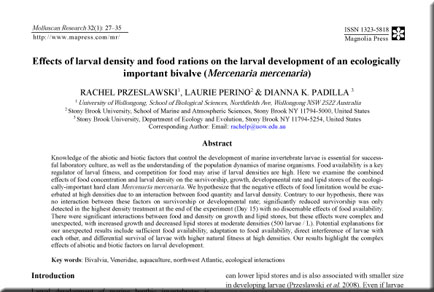Abstract
Knowledge of the abiotic and biotic factors that control the development of marine invertebrate larvae is essential for success-ful laboratory culture, as well as the understanding of the population dynamics of marine organisms. Food availability is a key regulator of larval fitness, and competition for food may arise if larval densities are high. Here we examine the combined effects of food concentration and larval density on the survivorship, growth, developmental rate and lipid stores of the ecologi-cally-important hard clam Mercenaria mercenaria. We hypothesize that the negative effects of food limitation would be exac-erbated at high densities due to an interaction between food quantity and larval density. Contrary to our hypothesis, there was no interaction between these factors on survivorship or developmental rate; significantly reduced survivorship was only detected in the highest density treatment at the end of the experiment (Day 15) with no discernable effects of food availability. There were significant interactions between food and density on growth and lipid stores, but these effects were complex and unexpected, with increased growth and decreased lipid stores at moderate densities (500 larvae / L). Potential explanations for our unexpected results include sufficient food availability, adaptation to food availability, direct interference of larvae with each other, and differential survival of larvae with higher natural fitness at high densities. Our results highlight the complex effects of abiotic and biotic factors on larval development.

